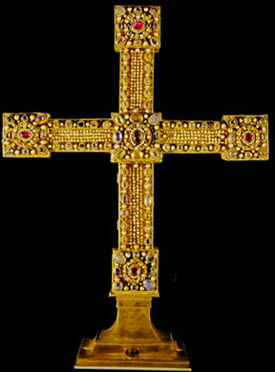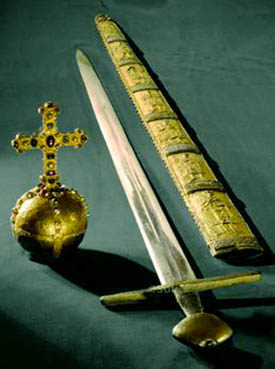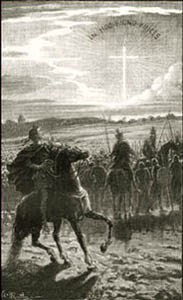 |
Feasts of Our Lord
The Exaltation of the Holy Cross
- September 14 -
Prof. Plinio Corrêa de Oliveira
You know that in ancient times the cross was an instrument of torment. It was ignominious for any person to be crucified. It was a dishonor for the person, as well as for his family. Aware of this, St. Paul asked not to be crucified because he was a Roman citizen, and Roman citizens were not subject to crucifixion. He was beheaded with a sword because this was a privilege of the Romans.

The Cross of the Holy Roman Empire glorified with gold, silver and precious stones. Below, the imperial orb, sword and scabbard of the Holy Roman Empire

|
When Our Lord Jesus Christ was crucified, therefore, he suffered a terrible humiliation. That shame was meant to signify that He was a bandit, an outlaw of the same genre of the two thieves with whom He was crucified. In this sense the crucifixion was not only a humiliation, but the highest possible humiliation for any honest man.
You know that the Jews inflicted every humiliation they could upon Our Lord during His life. This corresponded to their increasing hatred for the good He represented. Finally, they served to Him the supreme humiliation, which was the sacrifice of the Cross. With this they became the Deicide people.
Their desire to humiliate Our Lord as much as they could became evident in the Passion. For example, the crown of thorns, the tunic of the fool, the cane they placed in His hands as a scepter, the persons who ridiculed Him and spat at Him, etc., express the desire to torment Him not only in His Most Sacred Body, but also in His Most Holy Soul.
The Cross of Our Lord became the starting point of all the humiliations that all Catholics would have to bear until the end times for the cause of Our Lord Jesus Christ.
The forces of impiety never set aside their weapons against the good. They are always seeking to humiliate and break the morals of the good. None of you have been free from these humiliations because of your fidelity to Our Lord. It is an honor for us. To be persecuted for the love of Jesus Christ is one of the beatitudes. All of us had suffered these humiliations and will suffer them to the end of History because of the continuous outrages the impious ones make against God.
But, in parallel, the honor of God, the honor of Our Lord Jesus Christ, is vindicated by the Church. Catholics take the Cross as a symbol of honor, as the most sacred and holy thing we have, as the symbol of our redemption. Because of this sentiment, on the top of every Catholic church a Cross is placed; on the top of the most majestic crowns, the Cross is planted.
Many of the greatest families have the Cross on their coat-of-arms. Catholic decorations that reward the heroic deeds of a military man or the generosity of a great benefactor have the shape of the Cross.
These are manifestations of the Catholic spirit which vindicate that humiliation; they vindicate it with chivalric panache, with supernatural panache. With this special manifestation of love, that is, a reaction against the outrage of the enemies, the Catholic Church celebrates the feast of the Exaltation of the Holy Cross.

The Cross placed on top of the Cathedral of Cologne's towers
|
To exalt the Holy Cross is to glorify it. The word ex-altare in Latin means to elevate, to raise to a high place, which is to glorify.
The first sign of this was the apparition of the Cross in the sky to Constantine before the battle of Milvia Bridge. Above that Cross was written these words In Hoc Signo Vinces – Under the sign of the Cross you will conquer. That Cross which appeared in the sky for the first time then would remain on the horizon of all mankind throughout History, humiliating the evil ones and the devils.
The Cross would also be the sign of our honor. Our honor does not lie in avoiding humiliations, but in receiving them with panache and a spirit of challenge. To those who humiliate us, we should respond as knights and we should glorify the Cross of Our Lord even more proudly.
This is what exaltation means. It is to proclaim the glory of God in the face of His enemies' attempt to humiliate Him. Our attitude should smash the enemy's attempts to humiliate Our Lord.

The vision of Constantine
|
There is an ejaculation in the litany of the rogations, which is this: Ut inimicos Sanctae Matris Ecclesiae humiliare digneris, Te rogamus audi nos– That Thou wouldst deign to humiliate the enemies of the Holy Mother Church, we beseech Thee, hear us. So, the Church teaches us to pray for the humiliation of our enemies. Therefore, the best way to respond to the enemies who attempt to humiliate the Cross of Our Lord and His followers is to humiliate those enemies; it is to humiliate those who inflict humiliations.
Doing this, we rescue the Cross that lays in the dust of the despised, and raise it to the highest place. We glorify what had been humiliated. This is the essence of the exaltation of the Holy Cross.
False and sentimental piety takes an opposite position regarding the Cross. It never thinks of the counter-attack Catholics should make to exalt the Cross. The man with this sentimental mentality only cultivates syrupy sentiments regarding the Cross and if he ever considers its enemies, it is to flee from them under the pretext that he is forgiving them. With this mentality the Church will never have the true exaltation of the Holy Cross.
To the contrary, when someone tries to humiliate the Cross, we must respond with an even stronger counter-attack. Not in defense of our honor, but in defense of the honor of Our Lord Jesus Christ.


Read an Objection to These Comments

  | | Prof. Plinio Corrêa de Oliveira | |
The Saint of the Day features highlights from the lives of saints based on comments made by the late Prof. Plinio Corrêa de Oliveira. Following the example of St. John Bosco who used to make similar talks for the boys of his College, each evening it was Prof. Plinio’s custom to make a short commentary on the lives of the next day’s saint in a meeting for youth in order to encourage them in the practice of virtue and love for the Catholic Church. TIA thought that its readers could profit from these valuable commentaries.
The texts of both the biographical data and the comments come from personal notes taken by Atila S. Guimarães from 1964 to 1995. Given the fact that the source is a personal notebook, it is possible that at times the biographic notes transcribed here will not rigorously follow the original text read by Prof. Plinio. The commentaries have also been adapted and translated for TIA’s site.
|
Saint of the Day | Home | Books | CDs | Search | Contact Us | Donate

© 2002- Tradition in Action, Inc. All Rights Reserved
|
 |

|